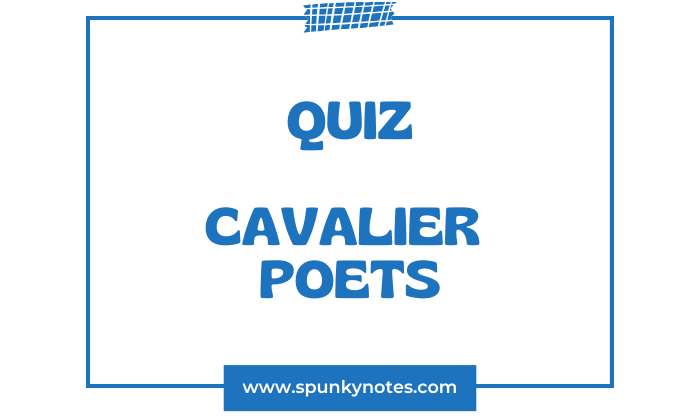

Estimated Reading Time: 16 min
Cavalier Poets Quiz
1. The Cavalier poets were a school of English poets belonging to which century?
A. 16th century
B. 17th century
C. 18th century
D. 19th century
2. During the English Civil War, the Cavalier poets primarily supported which figure?
A. Parliament
B. Oliver Cromwell
C. King Charles I
D. James II
3. What was the original meaning of the term “Cavalier” before it was applied to King Charles’s supporters?
A. A loyal courtier
B. A religious cleric
C. A mounted soldier or knight
D. A Parliamentary official
4. The opposing group to the Cavaliers, who supported Parliament, were often referred to as the:
A. Royalists
B. Aristocrats
C. Roundheads
D. Metaphysicals
5. The term “Cavalier” when applied to Charles’s supporters was meant to portray them as:
A. Pious worshippers
B. Roistering gallants
C. Philosophical thinkers
D. Humble servants
6. Which poet, although not a courtier, is categorized as a Cavalier poet due to his style?
A. John Donne
B. Thomas Carew
C. Robert Herrick
D. Sir John Suckling
7. Cavalier poetry is generally known for avoiding traditional subject matter such as:
A. Sensuality and beauty
B. Love and honor
C. Religion and philosophy
D. Drinking and fellowship
8. What did Cavalier poetry aim to express, which was much livelier than works of their predecessors?
A. Deep religious doctrine
B. The intricacies of morality
C. Joy and simple gratification
D. Scientific discovery
9. What was a primary political intent of Cavalier poetry?
A. To advocate Puritan beliefs
B. To promote the crown (Charles I)
C. To support Parliamentary rebellion
D. To discuss agrarian reform
10. What type of references were commonly found in most Cavalier works?
A. Medieval romances
B. Allegorical and/or classical
C. Contemporary scientific
D. Modern political
11. Cavalier poets frequently drew upon the knowledge of which three ancient figures?
A. Plato, Aristotle, and Homer
B. Horace, Cicero, and Ovid
C. Virgil, Seneca, and Socrates
D. Caesar, Nero, and Livy
12. The general attitude mirrored in Cavalier poetry is often associated with the phrase:
A. Memento mori
B. Laissez-faire
C. Carpe diem
D. Cogito ergo sum
13. What is the literal meaning of the Latin phrase carpe diem?
A. Trust the future
B. Trust only the day
C. Live modestly
D. Seize the day
14. The themes commonly celebrated in Cavalier poetry include beauty, love, nature, sensuality, and:
A. Poverty and sacrifice
B. Social life and honor
C. Piety and virtue
D. Scientific method
15. Beyond promoting Loyalist principles, Cavalier poets also promoted seizing:
A. Religious clarity
B. Material wealth and sex
C. Abstinence and temperance
D. Scholarly pursuits
16. What kind of love was a characteristic of Cavalier poetry, where a woman was worshipped as perfect?
A. Romantic love
B. Courtly love
C. Platonic Love
D. Unrequited love
17. Cavalier poetry is often grouped into which category of poetry due to its main intent?
A. Romantic
B. Philosophical
C. Political
D. Religious
18. When did Cavalier poetry begin to be recognized as its own genre?
A. Beginning of the Elizabethan era
B. After the execution of Charles I
C. Beginning of the English Civil War (1642)
D. During the Jacobean era
19. Which term describes the tone of the Cavalier poetry written after the conflict with Parliament began?
A. Triumphant
B. Nostalgic
C. Satirical
D. Pious
20. Charles I supported poets who created the art he:
A. Criticized
B. Craved
C. Funded
D. Ignored
21. In addition to embracing ancient ideas, what did the Cavaliers also incorporate into their poetry?
A. Strict moral codes
B. Their own contemporary ideas and thoughts
C. Metaphysical conceits
D. Puritan ethics
22. Besides metaphor, what is mentioned as another characteristic of Cavalier poetry?
A. Allegory
B. Fantasy
C. Paradox
D. Contemplation
23. English poets of the early seventeenth century are crudely classified into Cavaliers and:
A. Victorian poets
B. Romantic poets
C. Metaphysical poets
D. Augustan poets
24. The division between Cavalier and Metaphysical poetry approximates the division between:
A. Political/Secular
B. Secular/Religious
C. English/Scottish
D. Modern/Traditional
25. The Jacobean era poet regarded as the originator of the Cavalier poetic tradition is:
A. John Donne
B. John Milton
C. Ben Jonson
D. George Herbert
26. Which group of poets, concerned much with religion, are contrasted with the Cavaliers?
A. Tríbe of Ben
B. Sacred poets
C. Neoclassical poets
D. Castalian Band
27. Who is seen as the prime influence on the Cavalier Poets?
A. John Donne
B. Horace
C. Ben Jonson
D. Charles I
28. Many Cavalier poets were considered part of the ‘Tríbe of Ben’ or:
A. Sons of Jonson
B. Tríbe of Charles
C. Sons of Ben
D. Tríbe of Donne
29. Cavalier poets opposed metaphysical poetry, which often wrote with a focus that was spiritual, scientific, and:
A. Romantic
B. Moral
C. Political
D. Sensual
30. To Cavalier poets, what was considered more important than following moral codes?
A. Gaining political power
B. Writing complex verse
C. Enjoying life
D. Spiritual focus
31. Cavalier poetry is described as being both refined and:
A. Complex
B. Abstract
C. Straightforward
D. Ambiguous
32. Which feature of Cavalier poetry reflected coarseness and indecency prevalent in courtly circles?
A. Allegorical references
B. Metaphorical language
C. Mirrors temperament of Age
D. Focus on politics
33. What common format did cavalier poets use in their poems, according to the source?
A. Roses are red, violets are blue
B. AABB couplets
C. Blank verse
D. Petrarchan sonnets
34. Which prominent Cavalier poet was renowned for careless gaiety and wit?
A. Richard Lovelace
B. Thomas Carew
C. Robert Herrick
D. Sir John Suckling
35. Richard Lovelace fought on whose behalf during the Civil War?
A. Parliament
B. The king
C. The Puritans
D. John Donne
36. Which of these poems is one of Richard Lovelace’s best known works?
A. A Rapture
B. Odes
C. To Lucasta, Going to the Warres
D. Fragmenta aurea
37. The quoted lines “Stone walls do not a prison make, / Nor iron bars a cage” are from Richard Lovelace’s:
A. The Soldier
B. Sonnet To Generall Goring
C. To Althea, from Prison
D. Ballad upon a Wedding
38. The line “I could not love thee, dear, so much, Lov’d I not Honour more” is the end of which Lovelace poem?
A. To Althea, from Prison
B. To Lucasta, Going to the Warres
C. The Soldier
D. Fragmenta aurea
39. Richard Lovelace’s poetry was often influenced by his experiences with politics and his association with:
A. Military campaigns
B. Important figures of his time
C. Religious leaders
D. Scientific discovery
40. What influenced Thomas Carew’s metrical style?
A. Ovid
B. Donne
C. Jonson
D. Cicero
41. Which of the following themes was not common to the works of Cavalier poets such as Thomas Carew, Sir John Suckling, and Robert Herrick?
A. Loyalty to the king
B. Courtly ideals of the good life
C. Pious devotion to religious virtues
D. Carpe diem
42. Who of the following is a Cavalier poet?
A. George Herbert
B. John Donne
C. Robert Herrick
D. Andrew Marvell
43. Thomas Carew’s longest poem is:
A. To Celia
B. A Rapture
C. Fragmenta aurea
D. To Althea, from Prison
44. Thomas Carew’s elegy on which poet has been praised as a masterpiece of criticism?
A. Ben Jonson
B. Robert Herrick
C. John Donne
D. Richard Lovelace
45. Sir John Suckling is best known for which of the following poems?
A. To Lucasta
B. A Rapture
C. Ballad upon a Wedding
D. To the Virgins, to Make Much of Time
46. Sir John Suckling’s poem “A Sessions of the Poets” is the prototype of many later:
A. Elegies
B. Sonnets
C. Satires
D. Lyrics
47. The collection of Sir John Suckling’s poems that appeared in 1646 is titled:
A. The Soldier
B. Fragmenta aurea
C. Odes
D. The King’s Muse
48. Who wrote “Ballad upon a Wedding”?
A. Thomas Carew
B. Robert Herrick
C. Richard Lovelace
D. Sir John Suckling
49. Thomas Carew’s ‘Poems’ appeared in print in 1640 and contained amorous addresses to a fictional mistress known as:
A. Celia
B. Julia
C. Anne
D. Melanie
50. John Suckling belongs to the group of:
A. Metaphysical poets
B. Cavalier poets
C. Neo-classical poets
D. Religious poets
Brief Overview
The Cavalier Poets were a group of English writers active in the early 17th century. They wrote during the reign of King Charles I, who was eventually defeated in the English Civil War. They were loyal supporters of the King.
These poets were known for their elegant, charming style. They rejected the complicated, intellectual style of the Metaphysical poets. The Cavaliers followed the classical writing of figures like the Roman poet Horace.
Their poetry focused on themes of love, honor, loyalty, and the fleeting nature of life. Their work often featured the carpe diem theme, meaning “seize the day.” They encouraged living life fully in the present moment.
Prominent figures in this group included Robert Herrick, Richard Lovelace, and Sir John Suckling. Herrick’s famous line, “Gather ye rosebuds while ye may,” captures their philosophy perfectly. They often wrote about enjoying simple pleasures like wine, beauty, and good company.
After King Charles I was executed, the influence of the Cavalier Poets declined. Their style, however, remains a key part of the literary history of the period. They celebrated a world of aristocratic grace and beauty that was quickly coming to an end.


